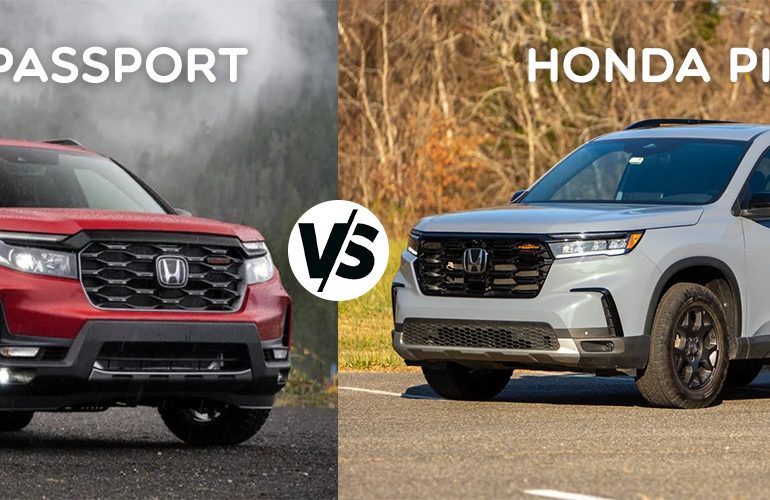Choosing between Honda’s two popular SUV offerings can be challenging when both vehicles share similar DNA yet serve different purposes. Both the Passport and Pilot represent Honda’s commitment to reliability, safety, and versatility, but understanding their distinct characteristics will help you make the right decision for your family’s needs.
Size and Seating: The Fundamental Difference
The most significant distinction between these Honda SUVs lies in their seating configurations and overall dimensions. The Pilot operates as a three-row midsize SUV, accommodating seven to eight passengers depending on the configuration you choose. The second-row captain’s chairs in higher trims lower the passenger capacity to seven but offer more comfort for the passengers.
The Passport takes a different approach, focusing exclusively on two-row seating for five passengers. This design philosophy prioritizes spaciousness for fewer occupants rather than maximum capacity. Both front rows have plenty of room for your head and legs, but the Passport gives extra space in the back for passengers, usually taken up by a third row.
Despite having fewer seats, the Passport maintains midsize SUV proportions, making it nearly as large as the Pilot in terms of exterior dimensions. This design choice results in exceptional cargo space and passenger comfort in the available seats.
Quick Comparison: Honda Passport vs Pilot
| Feature | Honda Passport | Honda Pilot |
| Seating Capacity | 5 passengers (2 rows) | 7-8 passengers (3 rows) |
| Engine | 3.5L V6, 285 hp, 262 lb-ft | 3.5L V6, 280 hp, 262 lb-ft |
| Transmission | 9-speed automatic | 10-speed automatic |
| Drivetrain | Standard AWD | FWD/AWD available |
| Towing Capacity | 5,000 lbs (AWD) | 5,000 lbs (AWD) |
| Fuel Economy | 20/25 mpg (city/highway) | 20/26 mpg (city/highway) |
| Starting Price | $42,445 (EX-L) | $38,605 (LX) |
| Cargo Space | 41.2 cu ft (behind 2nd row) | 16.5 cu ft (behind 3rd row) |
| Maximum Cargo | 77.7 cu ft | 84.3 cu ft (all seats folded) |
| Ground Clearance | 8.1 inches | 7.3 inches |
| Wheelbase | 111.0 inches | 111.0 inches |
| Overall Length | 190.5 inches | 196.5 inches |
Performance and Capability
Both vehicles share Honda’s proven 3.5-liter V6 engine, though with slight variations in power output. The Pilot produces around 280 horsepower, while the Passport generates approximately 285 horsepower. Both engines provide 262 pound-feet of torque, which gives enough power for everyday driving and merging onto highways.
The Honda Pilot and Honda Passport SUVs for sale have the same towing ability. Both use a powerful 3.5-liter V-6 engine, make 262 pound-feet of torque, and can pull up to 5,000 pounds when they have all-wheel drive.
The transmission setup differs slightly between models. The Pilot has a 10-speed automatic transmission, and the Passport has a 9-speed automatic transmission. Both provide smooth shifting and contribute to respectable fuel economy figures.
All-Wheel Drive Systems
Honda offers all-wheel drive on both models, though availability varies by trim level. The Pilot provides both front-wheel drive and all-wheel drive options across most of its lineup, while recent Passport models come standard with all-wheel drive, reflecting Honda’s positioning of this vehicle as the more adventure-ready option.
Fuel Economy and Efficiency
Fuel efficiency represents another area where these SUVs show their similarities and differences. The lighter weight of the Passport, combined with its two-row configuration, typically results in slightly better fuel economy figures compared to the Pilot. However, the differences remain minimal, with both vehicles achieving respectable mileage for their size class.
The only thing to note is that the Pilot TrailSport has the worst fuel efficiency of both model lines, getting only 18 miles per gallon in the city and 23 miles per gallon on the highway.
Most configurations of both vehicles achieve ratings in the low-to-mid twenties for combined fuel economy, making them competitive within the midsize SUV segment.
Interior Features and Technology
Both Honda SUVs come well-equipped with modern technology and comfort features. The infotainment systems vary slightly, with Pilot drivers will receive a 7- or 9-inch touchscreen display, while Passport drivers receive an 8-inch touchscreen. All Passport trims are standard with SiriusXM Satellite Radio, HD Radio, and a wireless phone charger — features that come standard in higher Pilot trims.
The inside materials and how the car is built are the same in both models, showing Honda’s focus on making things last and being easy to use. The Passport’s interior benefits from the absence of third-row seating, allowing for more generous storage compartments and passenger space.
Pricing and Value Proposition
The pricing structure between these models reflects their different market positions. The base Passport EX-L model costs $42,445, which is more expensive because Honda removed front-wheel-drive choices. The Pilot, on the other hand, has more trim levels and different pricing options to choose from.
The Pilot’s lower starting price makes it attractive for budget-conscious families needing maximum seating capacity. However, the Passport’s standard all-wheel drive and premium features make its higher price reasonable for buyers who want both capability and luxury.
Off-Road and Adventure Capabilities
Both models offer TrailSport variants designed for light off-road adventures. These trims include enhanced ground clearance, all-terrain tires, skid plates, and modified suspension tuning. The Passport TrailSport, which has a shorter wheelbase and sharper approach angles, usually tackles tough terrain with more confidence compared to its bigger version.
The standard all-wheel drive system in the Passport also makes it more suitable for buyers who regularly encounter adverse weather conditions or unpaved roads.
Cargo Space and Practicality
Despite its smaller passenger capacity, the Passport offers competitive cargo space behind the second row. When the pilot’s third row is being used, the Passport actually offers more cargo space. However, the Pilot’s ability to fold both rear rows creates significantly more maximum cargo capacity for large items.
The Passport’s cargo area features a more usable shape due to its shorter overall length, making it easier to load bulky items without the interference of a third-row seat mechanism.
Which Honda SUV Should You Choose?
Your choice between the Honda Passport vs Pilot ultimately depends on your specific needs and priorities. If you have a big family or often share a ride, you might like the extra seats in the 2024 Pilot. But if you want top performance for all your outdoor trips, the Honda Passport could be a better fit for you.
The Pilot is great when you need to carry as many people as possible, making it perfect for big families or when you often need to transport groups. It also has a lower starting price and offers different trim levels, which makes it a good choice for people who are careful about their budget.
The Passport suits buyers who want a more premium, adventure-ready SUV without the complexity of third-row seating. Its standard all-wheel drive, generous cargo space, and enhanced off-road capability make it perfect for active lifestyles and smaller families who prioritize versatility over maximum passenger count.
Conclusion
The Honda Passport and Pilot are both great options in Honda’s SUV line, each fitting different needs well. The Pilot provides family-focused practicality with its three-row seating and competitive pricing, while the Passport offers a more premium, adventure-oriented experience with superior standard equipment and capability features. Consider your family size, driving habits, and budget when making your decision. Test driving both models will help you experience their unique characteristics firsthand and determine which Honda SUV aligns better with your lifestyle and transportation needs.






